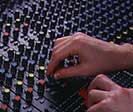| Author
|
An insight in2 melodies and psy
|
illusions
Erebus
Started Topics :
40
Posts :
626
Posted : Sep 29, 2006 14:32
|
jikkenteki: you'd make more than just a few people happy with a music 101 page + screenshots.
ill be waiting. |

|
|
Soth_MfK
IsraTrance Junior Member

Started Topics :
19
Posts :
261
Posted : Sep 29, 2006 14:49
|
very useful info from mr. jikkenteki, (although nothing new for me). another bit of advice:
its called the 2-5 pattern in jazz.
assume we're in a minor. the notes associated with a minor are: a, b, c, d, e, f, g, a. (maybe you know why i chose this scale  ). ).
mostly your sounds will be in a, because thats the "strongest", because its the prim or tonic.
if you make a break and want to build up tension,
you can make a half bar 2nd stage (thats b here) and a half bar 5th stage (thats e here). and in the next bar a (1st stage) again. that "leads" the listener into the next 8-bar loop.
every listener, doesn't matter how unmusical, will know how the beat and the music goes on. this combined with a snare roll is garanteed to get some shouts from the crowd 
hope 2 help,
Soth |

|
|
Freeflow
IsraTrance Full Member

Started Topics :
60
Posts :
3709
Posted : Sep 29, 2006 15:17
|
Soth_MfK - can you make a clip and tell more...
interesting with the tension of notes in a scale, if i can call it that...
could we also turn this into the tension of a chord progression? for climax/cresendo purpose...
Jikkenteki - thanks for the great information..
long time since i saw such informative thread and positive spirit from everybody 
Djzed - great info from you aswell..
ahh what the heck everybody has contributed in a good way...
shachar - thanks for clearing the drone question out..
|

|
|
UnderTow

Started Topics :
9
Posts :
1448
Posted : Sep 29, 2006 15:30
|
Quote:
|
On 2006-09-29 08:43, djzed wrote:
You are confused. Don't worry I don't blame you, theory can get very technical  . So I'm gonna try and help you out of your confusion. . So I'm gonna try and help you out of your confusion.
|
|
I don't mind technical but I'm just ignorant of music theory. I have feeling for the actual music though. When working with people I can usualy say something like "Play that note 3 steps up and it will sound great". 99% of the time it works.
Quote:
|
It doesn't make any sense to say "this track uses these notes so it's major". Your question is like asking "If something is 3 meters wide, that makes it big, yeh?"
|
|
Well the bassline is in F and stays in F the whole track and all the notes used are F G A B. Isn't that an F major scale? Or is it more complicated than that?
Quote:
|
When we talk about scales, modes, chords and so on, we are talking about them with respect to the tonic note. In tonal music everything is relative to the tonic. The tonic could be any of the twelve notes in our musical system (C, C#, D, D# etc...). So the first step in analysing music is to figure out what the tonic is.
|
|
F. 
Quote:
|
Example: If the tonic is C, then D is the second (II), E is the third (III) and so on.
|
|
Ah! That is actually simple.  I thought those numbers represented something more complex. I thought those numbers represented something more complex.
Quote:
|
Now, any scale or mode can just be seen as a sequence of intervals of Tones/Semitones, starting from whatever the tonic is. (if you go to a piano, a semitone is just a step from one note to the very next note, whether they be white or black, and a tone is two semitones.)
|
|
So far so good. I've had intervals explained to me once but as I don't use the theory I, of course, forgot exactly what they are called.
Quote:
|
The major scale is following sequence: - T - T - S - T - T - T - S -
The phrygian mode is this sequence: - S - T - T - T - S - T - T -
So the notes of C major are: C D E F G A B C
The notes of C phyrigian are: C Db Eb F G Ab Bb C
The notes of E phryhgian are: E F G A B C D E
If this doesn't make any sense to you, you'll need to go to a piano to see what I mean. You can see from the example above that the notes of C major and E phrygian happen to be exactly the same, but that doesn't mean they are the same scale because the TONIC is different.
So theres music theory 101. Hope it helps  . .
|
|
Yes this all makes sense. I just need to actually practise with it so that it sticks in memory. I think I need piano lessons.
I mean I know what works and what doesn't just by listening but I'm shure it would be much faster working if I just knew where to go next instead of having to try the different notes untill I find what I want. Also, when I do find what I want, it is much harder to memorise a progression (especially chords) because I basicly have to memorise each key visually as I have no reference.
Things get really tough after a bit of a smoke. 
UnderTow
|

|
|
UnderTow

Started Topics :
9
Posts :
1448
Posted : Sep 29, 2006 15:32
|
Quote:
|
On 2006-09-29 10:29, Jikkenteki wrote:
Another way you could think of the rhythmic bit is that if you changed all the notes of your melody into simple snare hits, would it make for an usable percussion line....
All this talk of theory has got me thinking about doing a music theory 101 for trance page on my website someday. I always think about this when people start arguing over what time signatures are and confusing them with triplets and such. Maybe a page with screen shots and graphics to make it all understandable would be a good reference. Although when I'd have to time to make it is another issue.. lol
|
|
That would be excellent!  I would suggest giving examples in small MIDI files. Hearing is the best. I would suggest giving examples in small MIDI files. Hearing is the best. 
Btw, when I write lines, I notice that just the rythm isn't enough. A line with all the same notes might not quite work but when you pull one of the notes up to the next octave (or whatever) it suddenly has that needed tenssion between that and the other notes.
I see things visually. So to me having a note an octave up is like a bigger movement than just moving to a the same note. Physically the instrument has to move all the way up there and all the way back down. Suddenly the timing between those notes makes sense because, as the physicall distance is bigger, the "musical object" is moving a much greater distance in the same time. So suddenly you have real speed where there was little speed before.
Does that make sense?
UnderTow |

|
|
UnderTow

Started Topics :
9
Posts :
1448
Posted : Sep 29, 2006 15:46
|
Quote:
|
On 2006-09-29 14:06, Boobytrip wrote:
@ Undertow: amazing choons you have there (who needs music theory anywayz  ), looking forward to hear the rest ), looking forward to hear the rest
|
|
Thanks Daan! 
When I listen to those MP3s you posted, I don't actually have a preference. None sound better, rather they give different moods. When I listen to each sequence individually I automaticly imagine a progression that comes before or after. There is an imagined context.
Some of the contexts are happier or darker or more tense or whatever. So depending on that context and the mood I would want to portray, the different sequences would work better or worse. So as such, although they sound different, none is "better" than the other.
Btw, what was that book you recomended when you were at my place?
UnderTow |

|
|
Jikkenteki
Jikkenteki

Started Topics :
20
Posts :
356
Posted : Sep 29, 2006 16:19
|
Quote:
|
On 2006-09-29 15:30, UnderTow wrote:
Well the bassline is in F and stays in F the whole track and all the notes used are F G A B. Isn't that an F major scale? Or is it more complicated than that?
|
|
Actually that would be F lydian (f,g,a,b,c,d,e,f), but your point is still valid because the lydian scale is played over a major chord and is a "major" sounding scale. The only difference is that the 4th note, B in the case of F lydian, is a half step higher than in a traditional major scale, in F major's case F,G,A,Bb,C,D,E,F.
As for this trance theory idea, I think I'll give it a try. However it will take me some time to do it how I want to, so don't expect it in the next couple days or anything. 
        New Album: Jikkenteki - Flights Of Infinity New Album: Jikkenteki - Flights Of Infinity
Available for free at http://www.ektoplazm.com/free-music/jikkenteki-flights-of-infinity/
PAR-2 Productions http://www.par-2.com |

|
|
Soth_MfK
IsraTrance Junior Member

Started Topics :
19
Posts :
261
Posted : Sep 29, 2006 16:20
|
@New Era Scientist: ok i'll make a clip in the evening and upload it. b00m
|

|
|
Freeflow
IsraTrance Full Member

Started Topics :
60
Posts :
3709
Posted : Sep 29, 2006 17:21
|
Soth - cool man.. im looking forward to learing more  nice of you to take the time.. nice of you to take the time..
|

|
|
Soth_MfK
IsraTrance Junior Member

Started Topics :
19
Posts :
261
Posted : Sep 29, 2006 18:44
|
|
Freeflow
IsraTrance Full Member

Started Topics :
60
Posts :
3709
Posted : Sep 29, 2006 19:52
|
Awsome Soth, Quality is sweet, very good sounding aswell, i want to hear more of this, hehe..
this arp pattern is it A B A B E? like you described before?
so for a build up of tension you go to E... you could also go to G from E for a extra tension build up or would that be the release later on?
i wonder the difference between playing from a scale and playing different chord progressions..
|

|
|
Soth_MfK
IsraTrance Junior Member

Started Topics :
19
Posts :
261
Posted : Sep 29, 2006 21:34
|
ok .. the tonic of this riff is f, and its like one bar f, one bar eb, one bar gb. in the break i use one bar gb (2nd stage) and one bar bb (5th stage). the arpeggiator is the vanguard inbuilt thing. if you want, i can upload it once more without arpeggio.
in a it would be like | a | f bb | three times and for the build up | bb | eb | because its not strictly minor in this example but a "church" scale, i dont remember how it is called. mr. jikkenteki will tell you that 
i dont quite get what you mean by "playing from scale" and chord progressions.
but i try to explain.
lets take the a minor example again.
a - b - c - d - e - f - g - a
ok you play a a minor chord - no problem, it would be like a - c - e. ok lets say you want to play a different chord that fits to the original one - take for example the quint (5th stage) (1st stage and 5th stage _always_ fit together).
you know the notes which you can play to stay in scale from above. so you take e. ok whats the second tone that fits with the e, but also with the original a minor chord ? its g ! and the third one would be obviously be b.
the only important thing to when talking about scales is to stay in scale, and only if you know what you're doing, step out of it. unfortunately, this is done a lot in psytrance 
ok a "trick from soth's vault":
when writing a bassline or a 1/16 lead, the diminished 9 is used a lot. when talking about a minor, this would be gb. so you play for example (for a bassline) - 1 8 1 - 1 8 1 - 1 8 b9 - 8 b9 b7 .
note wise this would be a (for 1 and 8), gb (for 9) and f (for 7).
ok i gotta drive to my djset now, i hope i could help you. don't be afraid to ask more.
cheers,
Soth
(btw. the MfK means Music for Kobolds, my Partycrew;) )
|

|
|
Freeflow
IsraTrance Full Member

Started Topics :
60
Posts :
3709
Posted : Sep 29, 2006 22:42
|
|
Soth - cool, im going to digest this and return later..
|

|
|
psylevation
IsraTrance Full Member

Started Topics :
52
Posts :
841
Posted : Sep 29, 2006 23:26
|
sweet, tons of information here. It's strange just about 2 weeks ago I picked up a book and a larger keyboard, and this thread just blew up...mabye I should keep on going with the learning of the music theory.
I've learned a few ways to give tension and release using the middle finger in a triad. while your playing a three note chord, you can try moving your middle finger up 2 steps from where it was, then down 1 step from where it was, then back to the place it was again. This is if using a minor chord.
The nice thing about this was that even if i'm not using a chord, I can pick a key to play in, I've got the 3 keys of the triad, then the other 2 there at least.
This has been very helpfull because, i'm not just trying notes at random till it sounds good, I've got ideas on where to try different notes on the keyboard once i've picked a key.
There is also the moving up a semi tone or 2 with the little finger from the chord, and maybe down a step with your thumb, assuming you're playing with your right hand only. These ones don't always work but you find out really quick which ones do, then you know what keys you have to work with in your song.
I can't even imagine how much it would help if I were to actually completely understand music theory, seeing that I've already gotten this much help from just a couple little tricks. So please continue on with the awesome discussion!
Oh one more thing, stray out from that root key using these notes, then find your way back home to that root key, it'll make it feel complete. Thats all I've got for now |

|
|
Boobytrip
IsraTrance Junior Member

Started Topics :
39
Posts :
988
Posted : Sep 30, 2006 20:30
|
@Undertow: the books were called "The complete idiot's guide to music theory" and "The complete idiot's guide to music composition". You're no idiot of course, but i'm sure you can pick up something useful  Also the book "how music really works" seems to be pretty good. Also the book "how music really works" seems to be pretty good.
|

|
|
|